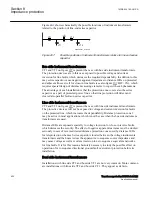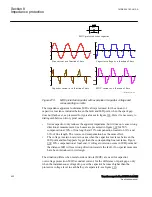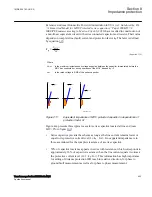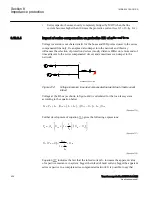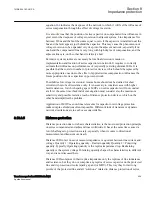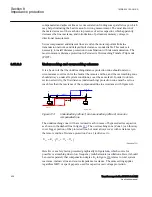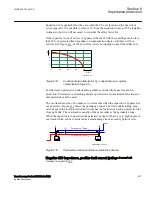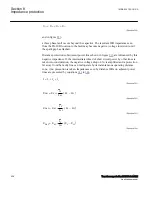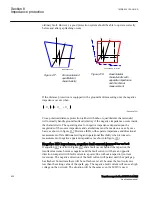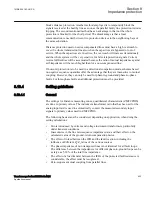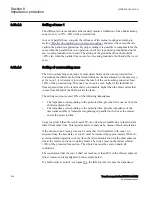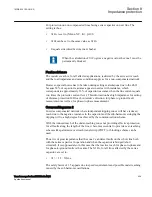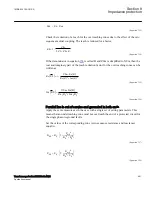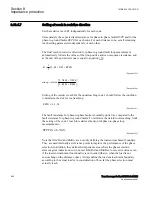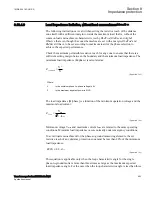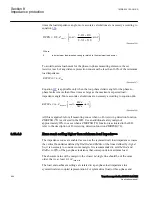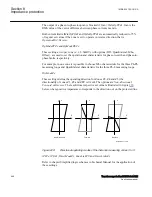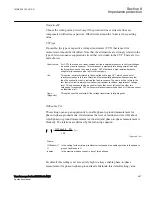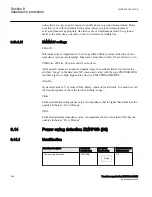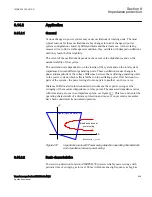
8.13.4.2
Setting of zone 1
GUID-12E84C05-93A2-4FA3-B7BA-0963FB1C098F v1
The different errors mentioned earlier usually require a limitation of the underreaching
zone (zone 1) to 75%...90% of the protected line.
In case of parallel lines, consider the influence of the mutual coupling according to
section
"Parallel line application with mutual coupling"
and select the case(s) that are
valid in the particular application. By proper setting it is possible to compensate for the
cases when the parallel line is in operation, out of service and not grounded and out of
service and grounded in both ends. The setting of the ground-fault reach should be
<85% also when the parallel line is out of service and grounded at both ends (the worst
case).
8.13.4.3
Setting of overreaching zone
GUID-E5F09722-47BB-47E2-80B1-8D47DA44A158 v1
The first overreaching zone (zone 2) must detect faults on the whole protected line.
Considering the different errors that might influence the measurement in the same way
as for zone 1, it is necessary to increase the reach of the overreaching zone to at least
120% of the protected line. The zone 2 reach can be even higher if the fault infeed
from adjacent lines at the remote end is considerably higher than the fault current that
comes from behind of the IED towards the fault.
The setting must not exceed 80% of the following impedances:
•
The impedance corresponding to the protected line, plus the first zone reach of the
shortest adjacent line.
•
The impedance corresponding to the protected line, plus the impedance of the
maximum number of transformers operating in parallel on the bus at the remote
end of the protected line.
Larger overreach than the mentioned 80% can often be acceptable due to fault current
infeed from other lines. This requires however analysis by means of fault calculations.
If the chosen zone 2 reach gives such a value that it will interfere with zone 2 on
adjacent lines, the time delay of zone 2 must be increased by approximately 200 ms to
avoid unwanted operation in cases when the telecommunication for the short adjacent
line at the remote end is down during faults. The zone 2 must not be reduced below
120% of the protected line section. The whole line must be covered under all
conditions.
The requirement that the zone 2 shall not reach more than 80% of the shortest adjacent
line at remote end is highlighted in the example below.
If a fault occurs at point F, see figure
, the IED at point A senses the impedance:
Section 8
1MRK 504 163-UUS A
Impedance protection
434
Transformer protection RET670 2.2 ANSI
Application manual
Summary of Contents for RELION RET670
Page 1: ...RELION 670 SERIES Transformer protection RET670 Version 2 2 ANSI Application manual ...
Page 2: ......
Page 48: ...42 ...
Page 64: ...58 ...
Page 74: ...68 ...
Page 104: ...98 ...
Page 194: ...188 ...
Page 518: ...512 ...
Page 618: ...612 ...
Page 648: ...642 ...
Page 666: ...660 ...
Page 672: ...666 ...
Page 682: ...676 ...
Page 844: ...838 ...
Page 868: ...862 ...
Page 956: ...950 ...
Page 964: ...958 ...
Page 1004: ...998 ...
Page 1014: ...1008 ...
Page 1015: ...1009 ...

